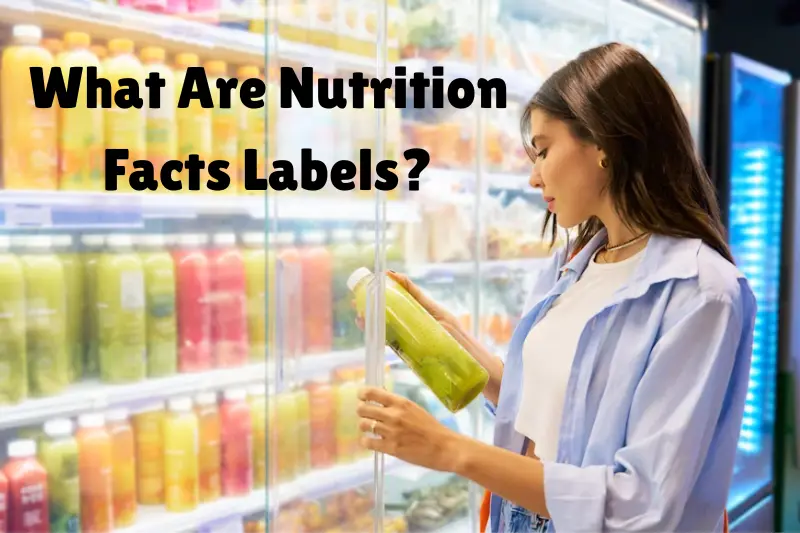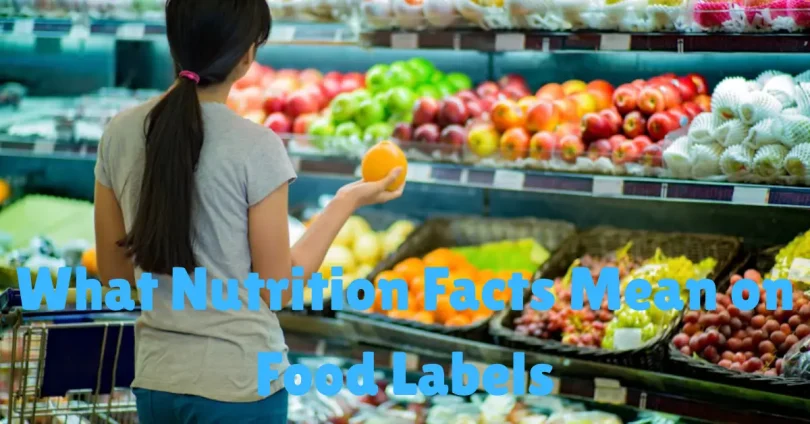Have you ever picked up a breakfast cereal or a bag of cookies and found yourself squinting at the Nutrition Facts label, wondering what all those numbers and percentages actually mean?
Don’t worry—you’re not the only one! At first glance, these labels can feel confusing, but learning what nutrition facts mean on food labels is one of the easiest ways to make smarter choices for your health.
Let’s break it down using everyday foods so you can shop, eat, and feel confident about what’s on your plate.
What Are Nutrition Facts Labels?

Nutrition Facts labels are essentially a food’s “report card.” They give you a clear snapshot of what’s inside the food you’re about to eat, including:
- Calories – the energy you get from the food
- Fats – including saturated, unsaturated, and trans fats
- Carbohydrates – including fiber and sugars
- Protein – essential for body repair and growth
- Vitamins and minerals – such as Vitamin D, calcium, iron, and potassium
The goal of these labels is simple: to help you understand what’s in each serving and how it fits into a healthy, balanced diet.
Serving Size: The First Step to Smart Eating
The first thing to check on any Nutrition Facts label is the serving size. This small detail makes a huge difference. The nutritional information listed is per serving, not per package.
For example:
- A bag of chips may list 1 serving = 10 chips, but the bag contains 50 chips.
- If you eat the whole bag, you need to multiply all numbers by 5—calories, fats, sugars, and more.
Understanding serving sizes helps you avoid underestimating calories and nutrients and ensures that you get an accurate picture of what you’re really consuming.
Calories: Fuel for Your Body

Calories measure the energy your body gets from food. Your body uses this energy to perform all functions, from breathing and walking to thinking and exercising.
- High-calorie foods: Can provide energy but may contribute to weight gain if consumed in excess.
- Low-calorie foods: Can help manage weight but may not always provide enough nutrients.
Nutrition labels typically base their percentages on a 2,000-calorie daily diet, which is a general guideline. Keep in mind that your needs may vary depending on age, activity level, and lifestyle.
You may also like to read this:
How Are Frozen Meals Made In Factories: Complete Guide
16 Common Types of Processed Foods You Eat Daily
Why People Prefer Ready-To-Eat Meals For Busy Lifestyles
13 Best Healthy Alternatives To Processed Meals For Everyone
Top Processed Food Brands In The Market Leading Innovation
Fats, Carbs, and Protein: Understanding Macronutrients
Nutrition labels break down food into macronutrients, which are essential for your body’s functioning.
Fats
Fats are vital for energy and brain function, but not all fats are created equal:
- Saturated fats: Often found in animal products and fried foods; too much can raise cholesterol.
- Trans fats: Artificial fats that are harmful and should be avoided.
- Unsaturated fats: Healthy fats found in olive oil, nuts, and fish that support heart health.
Carbohydrates
Carbs are the body’s main energy source. Nutrition labels show:
- Fiber: Supports digestion, helps you feel full, and maintains healthy blood sugar levels.
- Sugars: Includes naturally occurring sugars (like in fruit) and added sugars. Try to limit added sugars for better health.
Protein
Protein is essential for:
- Muscle growth and repair
- Keeping you full between meals
- Supporting hormones and enzymes
Foods rich in protein include meat, eggs, dairy, legumes, and plant-based alternatives like tofu and tempeh.
Percent Daily Value (%DV): Your Quick Reference Guide
One of the most helpful parts of the Nutrition Facts label is the Percent Daily Value (%DV). This percentage shows how much one serving of food contributes to the daily recommended intake of each nutrient, based on a 2,000-calorie diet.
- Aim lower: Added sugars, sodium, and unhealthy fats.
- Aim higher: Fiber, vitamins, and minerals.
For instance, a food with 20% DV of fiber gives you 20% of the fiber you need for the day in just one serving. This makes it easy to compare products and make smarter choices quickly.
Vitamins and Minerals: Micronutrients That Matter
Vitamins and minerals are often overlooked, but they play critical roles in overall health. Some examples include:
- Vitamin D: Supports bone health and immune function
- Calcium: Essential for strong bones and teeth
- Iron: Helps your body carry oxygen in the blood
- Potassium: Supports heart and muscle function
Choosing foods rich in these micronutrients helps fill dietary gaps and maintain long-term wellness.
Tips for Using Nutrition Facts Labels
Here’s how you can make the most of Nutrition Facts labels in your daily life:
- Check serving size first – everything depends on it.
- Limit added sugars – aim for a lower %DV.
- Focus on fiber and protein – they keep you full and satisfied.
- Compare products – use %DV to pick healthier options.
- Balance your diet – no single food contains everything; variety is essential.
- Read the ingredient list – labels show nutrients, but ingredients tell you what’s really in your food.
How to Read Between the Lines of Nutrition Labels
While the numbers and %DV give a good snapshot of a food’s nutritional profile, there’s more to labels than meets the eye. Here’s how to dig a little deeper:
1. Look Beyond Calories
Calories are important, but not all calories are equal. A 200-calorie candy bar and a 200-calorie serving of nuts provide the same energy but very different nutrients. Focus on the quality of calories: foods high in vitamins, minerals, fiber, and protein will keep you satisfied and healthy.
2. Pay Attention to Added Sugars
Many packaged foods contain added sugars that can sneak into your diet. Unlike natural sugars found in fruits or dairy, added sugars provide calories without nutrients. Keep an eye on the %DV for added sugars and try to choose foods with 5% DV or lower per serving when possible.
3. Sodium Counts
Excess sodium can contribute to high blood pressure and heart disease. Processed and packaged foods often contain hidden sodium. When reading labels, look for foods with 5% DV or less per serving for sodium.
4. Fiber Is Your Friend
Fiber is one of the most important nutrients for digestive health and satiety. A good rule of thumb: look for 3 grams or more of fiber per serving, or aim for 20% DV or higher.
5. Understand Ingredient Lists
The Nutrition Facts label works hand-in-hand with the ingredient list. Ingredients are listed in descending order by weight. Watch for:
- Hidden sugars (syrup, honey, dextrose)
- Artificial additives or preservatives
- Sources of unhealthy fats (partially hydrogenated oils)
Special Considerations
For Athletes and Active Individuals
If you exercise regularly, you may need more calories, protein, and certain micronutrients than the standard 2,000-calorie guideline. Use the Nutrition Facts label to customize your intake based on your activity level.
For People with Dietary Restrictions
Labels are especially useful if you have:
- Food allergies – check for common allergens like nuts, dairy, or soy
- Diabetes – monitor carbohydrates and added sugars
- Heart conditions – watch sodium and saturated fat
Tips for Families and Kids
Nutrition Facts labels can help parents make healthier choices for their children. Look for foods high in fiber, protein, vitamins, and minerals, while limiting added sugars and unhealthy fats. Teaching kids to read labels can set the foundation for lifelong healthy eating habits.
Making Nutrition Labels Work for You
- Plan Your Meals: Use labels to balance nutrients across the day.
- Compare Brands: Not all foods are created equal—labels make it easy to pick the better option.
- Set Personal Goals: Use %DV to track nutrients you want more of (like fiber) or less of (like sodium).
- Snack Smarter: Read labels before grabbing convenience foods; small changes add up.
- Stay Informed: Nutrition labels change over time—new versions may include updated %DV or added sugar info.
Conclusion
Understanding what nutrition facts mean on food labels is about empowerment. These labels aren’t just numbers—they’re a guide to making informed choices, managing your diet, and supporting your overall health. By learning to read serving sizes, calories, macronutrients, %DV, vitamins, and minerals, you can take control of your eating habits and make choices that align with your wellness goals.
Next time you shop, don’t just glance at the Nutrition Facts label—use it to plan, compare, and optimize your meals. Over time, reading labels will become second nature, helping you build a healthier, more balanced lifestyle for yourself and your family.
FAQs
1. What is a Nutrition Facts label?
A Nutrition Facts label is a panel on packaged foods that shows the nutritional content per serving, including calories, fats, carbohydrates, protein, vitamins, and minerals. It helps you understand how a food fits into a balanced diet.
2. Why is serving size important?
The serving size tells you how much of the food the nutrition information is based on. Eating more than the serving size means consuming more calories and nutrients than listed, so always check this first.
3. What does %DV mean?
%DV, or Percent Daily Value, indicates how much a nutrient in one serving contributes to a typical 2,000-calorie daily diet. Aim for lower %DV of added sugars, sodium, and unhealthy fats, and higher %DV of fiber, vitamins, and minerals.
4. Should I focus more on calories or nutrients?
Both matter. Calories show the energy you get, but nutrients tell you the quality of your food. Foods rich in fiber, protein, vitamins, and minerals are more beneficial than foods with empty calories.
5. How can I identify added sugars on a label?
Check the line labeled “Added Sugars” under carbohydrates. Ingredients like high-fructose corn syrup, cane sugar, or honey are examples of added sugars. Lower %DV is better.





